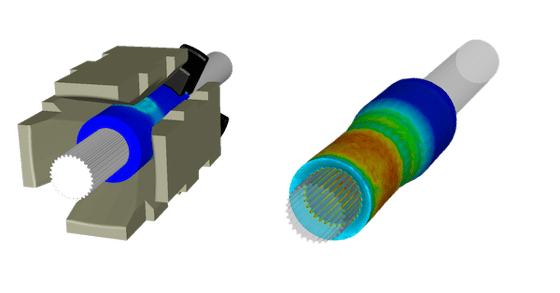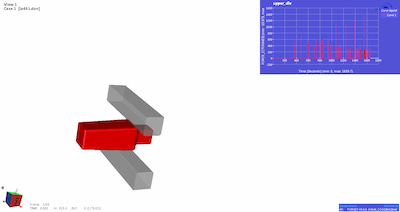Simulation of open-die forging processes with FORGE®
In open die forging, simulation is used for multiple objectives: to validate the equipment capacity, to optimize the forging plan, to predict the temperature distribution and possible reheats, the metallurgic changes and microstructure ...
FORGE® addresses major open-die forging processes: cogging, becking, mandrel drawing, blooming, etc. serving the energy industry as well as other industries.
Simulation of the becking of a steel-made shell. Temperature distribution is represented.
Predictive simulation
FORGE® allows the prediction of:
- Equipment capacity definition by accurate prediction of the compressive force
- The final dimensions of the component
- Flaws (folds/laps) detection
- Temperature distribution and therefore reheat required
- Strain and reduction ratio
- Porosity closing
- Metallurgy
competitive features of FORGE®
- All the movements of the workpiece can be described through a dedicated Multi-Pass Command File. This file allows to define the translation and rotation of the part, the displacements of the part at the end of one pass, the waiting time between each pass, etc.
- Complex piloting combining multiple body movements can be reflected by FORGE®. This is for example the case for mandrel drawing process.

- Metallurgy prediction: prediction of the grain size and recrystallized rates for multiple materials used in the energy industry.
- Die analysis: prediction of abrasive wear and stress. Coupling analysis is possible, offering, as an example, the possibility to run thermo-coupled analysis.
- Computation time reduction. As incremental processes, open-die processes are CPU time demanding. Dedicated and innovative technique is available for this type of process. This method, known as a bi-mesh method, relies on the automatic split between two meshes. One fine mesh to perform the thermal calculation and to store all the historical variables, and one adapted mesh for the mechanical computation in order to capture localized deformations. It is easy to set up by the definition of the fine mesh only, the adapted mesh being automatically deduced. It is fully compatible with HPC calculation.
- The heat treatment processes following the open-die forging operation can be simulated with FORGE® in order to predict residual stresses, distortion, hardness of the component.
- Coupling between the two Transavalor's software, THERCAST® and FORGE®, is possible and ensures the complete workflow simulation, from casting to forging. Results from casting simulation like are mapped to FORGE® and tracked during the forging simulation. Such coupling allows the porosities closing prediction during forging, the segregations localization in the final forging geometry.

Ingot cogging with press load prediction. With courstesy of Buderus Edelstahl




 The Spanish company Tubacex used FORGE® and THERCAST® to compare the quality of two manufacturing routes (hot forging and blooming) to produce round bars with a new ingot design. They have
The Spanish company Tubacex used FORGE® and THERCAST® to compare the quality of two manufacturing routes (hot forging and blooming) to produce round bars with a new ingot design. They have 
